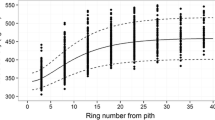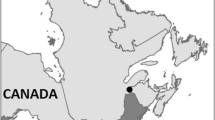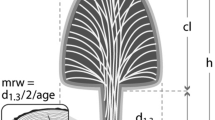Abstract
Context
It is widely accepted that ring area increment generally increases from the tree apex to the crown base and is more-or-less constant below the crown base (Pressler’s law), but few quantitative models of this distribution have been developed.
Aims
The aim of this study was to develop a model of ring area increment using easily obtained crown features and other tree or stand characteristics in order to further the understanding and prediction of tree growth, form, and wood quality.
Methods
The models were fit to stem analysis observations from white spruce, black spruce, balsam fir, and lodgepole pine.
Results
In the final model, which includes tree crown and stand variables, ring area increment within the crown region was slightly curvilinear, the slope of ring area increment below the crown was non-zero, and the effect of butt swell was appreciable up-to a relative height of 0.10.
Conclusions
The high accuracy of the mixed effects model suggests that the three-component model form is appropriate for describing ring area profiles, whereas some tree-to-tree variation remains unexplained. The tree and stand variables used in these models can be easily measured in the field or obtained from remote sensing techniques.




Similar content being viewed by others
References
Barczi J-F, Rey H, Caraglio Y, De Reffye P, Barthélémy D, Dong QX, Fourcaud T (2008) AmapSim: a structural whole-plant simulator based on botanical knowledge and designed to host external functional models. Ann Bot 101:1125–1138
Bevilacqua E, Puttock D, Blake TJ, Burgess D (2005) Long-term differential stem growth responses in mature eastern white pine following release from competition. Can J For Res 35:511–520
Burnham KP, Anderson DR (1998) Model selection and inference: a practical information-theoretic approach. Springer, New York, 353 pp
Courbet F (1999) A three-segmented model for the vertical distribution of annual ring area. Application to Cedrus atlantica Manetti. For Ecol Manage 119:177–194
Cruickshank M (2002) Accuracy and precision of measuring cross-sectional area in stem disks of Douglas-fir infected by Armillaria root disease. Can J For Res 32:1542–1547
Deleuze C, Houllier F (1995) Prediction of stem profile of Picea abies using a process-based tree growth model. Tree Phys 15:113–120
Deleuze C, Houllier F (2002) A flexible radial increment taper equation derived from a process-based carbon partitioning model. Ann For Sci 59:141–154
Fang Z, Bailey RL (2001) Nonlinear mixed effects modeling for slash pine dominant height growth following intensive silvicultural treatments. For Sci 47:287–300
Farrar JL (1961) Longitudinal variation in the thickness of the annual ring. For Chron 37:323–330, 349
Fonweban J, Gardiner B, Macdonald E, Auty D (2011) Taper functions for Scots pine (Pinus sylvestris L.) and Sitka spruce (Picea sitchensis (Bong.) Carr.) in Northern Britain. Forestry 84:49–60
Gaffrey D, Sloboda B (2001) Three mechanics, hydraulics and needle-mass distribution as a possible basis for explaining the dynamics of stem morphology. J For Sci 47:241–254
Gilmore DW, Seymour RS (1997) Crown architecture of Abies balsamea from four canopy positions. Tree Phys 17:71–980
Groom JD, Hann DW, Temesgen H (2012) Evaluation of mixed-effects models for predicting Douglas-fir mortality. For Ecol Manage 276:139–145
Groot A (2002) Is uneven-aged silviculture applicable to peatland black spruce (Picea mariana) in Ontario, Canada? Forestry 75:437–442
Groot A, Saucier J-P (2008) Volume increment efficiency of Picea mariana in northern Ontario, Canada. For Ecol Manage 255:1647–1653
Houllier F, Leban J-M, Colin F (1995) Linking growth modelling to timber quality assessment for Norway spruce. For Ecol Manage 74:91–102
Huang S, Wiens DP, Yang Y, Meng SX, Vanderschaaf CL (2009) Assessing the impacts of species composition, top height and density on individual tree height prediction of quaking aspen in boreal mixedwoods. For Ecol Manage 258:1235–1247
Hyink DM, Zedaker SM (1987) Stand dynamics and the evaluation of forest decline. Tree Phys 3:17–26
Ikonen VP, Kellomäki P, Väisänen H, Peltola H (2006) Modelling the distribution of diameter growth along the stem in Scots pine. Trees 20:391–402
Jozsa LA, Middleton GR (1994) A discussion of wood quality attributes and their practical implications. Special Publication No. SP-34, Forintek Canada Corp., Vancouver. 51 p
Kershaw JA Jr, Maguire DA (2000) Influence of vertical foliage structure on the distribution of stem cross-sectional area increment in western hemlock and balsam fir. For Sci 46:86–94
Kershaw JA Jr, Benjamin JG, Weiskittel AR (2009) Approaches for modeling vertical distribution of maximum knot size in black spruce: a comparison of fixed- and mixed-effects nonlinear models. For Sci 55:230–237
Labyak LF, Schumacher FX (1954) The contribution of its branches to the main-stem growth of Loblolly pine. J For 52:333–337
Larson PR (1963) Stem form development of forest trees. For Sci Monogr 5
Lavigne MB (1991) Effects of thinning on allocation of growth and respiration in young stands of balsam fir. Can J For Res 11:459–464
Leckie D, Gougeon F, Hill D, Quinn R, Armstrong L, Shreenan R (2003) Combined high-density Lidar and multispectral imagery for individual tree crown analysis. Can J Remote Sens 29:633–649
Li C (2009) Toward full, multiple, and optimal wood fibre utilization: a modeling perspective. For Chron 85:377–381
Maguire DA, Bennett WS (1996) Patterns in vertical foliage distribution of foliage in young coastal Douglas-fir. Can J For Res 26:1991–2005
Mansfield SD, Parish R, Goudie JW, Kang K-Y (2007) The effects of crown ratio on the transition from juvenile to mature wood production in lodgepole pine in western Canada. Can J For Res 37:1450–1459
Max TA, Burkhart HE (1976) Segmented polynomial regression applied to taper equations. For Sci 22:283–289
Mitchell KJ (1975) Dynamics and simulated yield of Douglas-fir. For Sci Monogr 17
Newberry JD (1991) A note on Carmean’s estimate of height from stem analysis data. For Sci 37:368–369
Osawa A, Ishizuka M, Kanazawa Y (1991) A profile theory of tree growth. For Ecol Manage 41:33–63
Ottorini J-M, Le Goff N, Cluzeau C (1996) Relationships between crown dimensions and stem development in Fraxinus excelsior. Can J For Res 26:394–401
Panshin AJ, de Zeuw C (1970) Textbook of wood technology. McGraw-Hill, New York, 705 p
Pitt D, Lanteigne L (2008) Long-term outcome of precommercial thinning in northwestern New Brunswick: growth and yield of balsam fir and red spruce. Can J For Res 38:592–610
Pinheiro JC, Bates DM, DebRoy S, Sarkar D, and the R Core team (2009) NLME: Linear and Nonlinear Mixed Effects Models. R package version 3.1-96
Pinherio JC, Bates DM (2000) Mixed-Effects Models in S and S-Plus. Springer-Verlag, New York
Pressler MR (1864) Das Gesetz der Stammbildung. Arnoldische Buchhandlung, Leipzig, 153 p
Saranpää P (2003) Wood density and growth. In: Barnett, J.R. and Jeronimidis, G (eds) Wood quality and its biological basis. CRC Press, Boca Raton, pp. 87–117
Sprugel DG, Hinckley TM, Schaap W (1991) The theory and practice of branch autonomy. Annu Rev Ecol Syst 22: 309–334
Watt MS, Zoric B, Kimberley MO, Harrington J (2011) Influence of stocking on radial and longitudinal variation in modulus of elasticity, microfibril angle, and density in a 24-year-old Pinus radiate thinning trial. Can J For Res 41:1422–1431
Weiner J (1984) Neighbourhood interference amongst Pinus rigida individuals. J Ecol 72:183–195
Xu P, Walker JCF (2004) Stiffness gradients in radiata pine trees. Wood Sci Technol 38:1–9
Acknowledgments
Special thanks go to: Mr. Jim Goudie of the BC Ministry of Forests, Lands, and Natural Resource Operations for providing the lodgepole pine data; Dr. Doug Pitt of the Canadian Forest Service for supplying the balsam fir data, Mr. Andrew Innerd for sharing white spruce samples; Mr. Ian Cameron of Azura Formetrics for assistance with the statistical analysis; and Mr. Gurp Thandi of the Canadian Forest Service for creating the map presented in this manuscript. The authors would also like to thank the two anonymous reviewers for providing constructive comments and suggestions.
Funding
Funding of this research was provided by the Canadian Wood Fibre Centre (Canadian Forest Service).
Author information
Authors and Affiliations
Corresponding author
Additional information
Handling Editor: Jean-Michel Leban
Contributions of the co-authors
Francesco Cortini: data analysis, modeling, and writing
Arthur Groot: experimental design, modeling, and writing
Cosmin N. Filipescu: modeling and writing
Rights and permissions
About this article
Cite this article
Cortini, F., Groot, A. & Filipescu, C.N. Models of the longitudinal distribution of ring area as a function of tree and stand attributes for four major Canadian conifers. Annals of Forest Science 70, 637–648 (2013). https://doi.org/10.1007/s13595-013-0305-9
Received:
Accepted:
Published:
Issue Date:
DOI: https://doi.org/10.1007/s13595-013-0305-9




